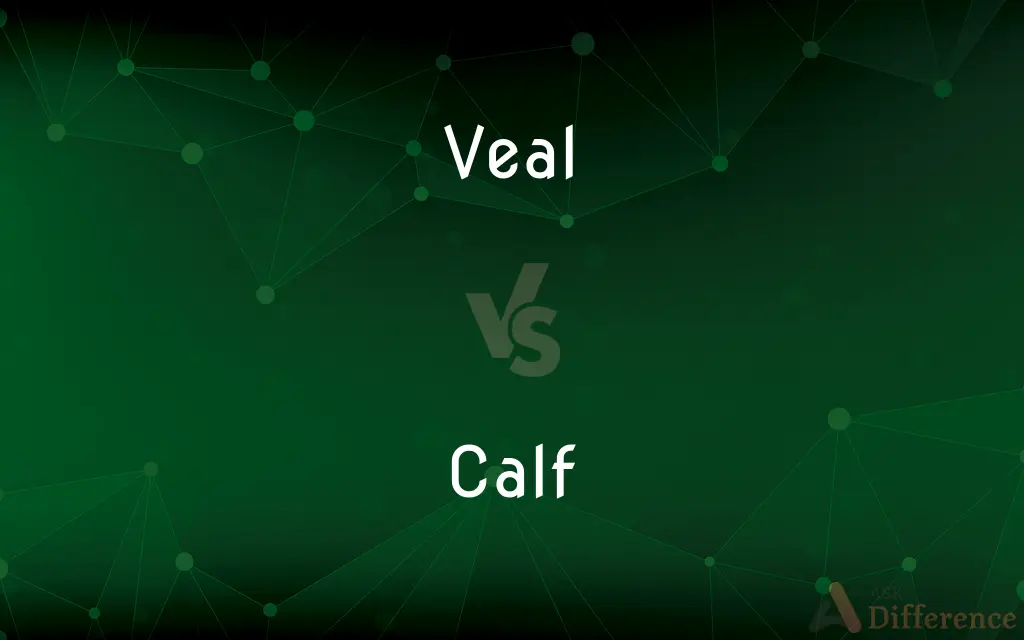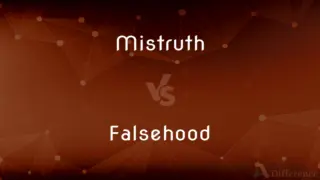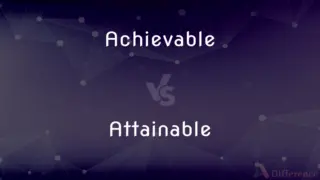Veal vs. Calf — What's the Difference?
Edited by Tayyaba Rehman — By Fiza Rafique — Updated on November 3, 2023
Veal is the meat from a young calf, whereas a calf is a young bovine animal.

Difference Between Veal and Calf
Table of Contents
ADVERTISEMENT
Key Differences
Veal refers to the meat that comes from young cattle, typically under six months old. It is known for its tender texture and is considered a delicacy in many cuisines. Calves, on the other hand, are young bovine animals themselves, not yet mature and varying in age from birth up to a year or so, depending on the context.
The term veal is specifically related to the culinary context and the butchery of calves. A calf is an infant mammal of the species Bos taurus, and while all veal comes from calves, not all calves are raised to become veal. The distinction is important for both farmers and consumers for various ethical, economic, and dietary reasons.
In discussing veal, the conversation often revolves around the flavor, cooking methods, and recipes that highlight its delicate taste and texture. When speaking of a calf, the topics may include breeding, animal husbandry, and the role of the calf in agricultural settings. Both veal and calf are significant terms in livestock and culinary fields but pertain to different stages of a bovine's life.
Veal production is a subset of the beef industry and is regulated by standards that dictate how the calves are raised and when they are butchered. Calves, meanwhile, are not defined by their use for meat but can be raised for a variety of purposes, including eventually becoming dairy cows or beef cattle.
While veal is the end product consumed on the dinner plate, the calf's journey encompasses more than just its potential as a food source. The relationship between veal and calf is integral, one symbolizing youth and potential and the other a specialized food product that carries its own culinary and cultural significance.
ADVERTISEMENT
Comparison Chart
Definition
Meat from young cattle.
A young bovine animal.
Age
Comes from calves under 6 months old.
Refers to bovines from birth to 1 year.
Use
Used as a food product.
Raised for various purposes.
Context
Culinary.
Agricultural and animal husbandry.
Significance
Considered a delicacy.
Represents youth and potential in bovines.
Compare with Definitions
Veal
A term denoting the meat from young dairy breed calves.
The menu featured a special of veal with a mushroom sauce.
Calf
A term for the young of domestic cattle.
The calves were being weaned at the dairy farm.
Veal
The culinary term for the flesh of a calf used as food.
Veal is often used in Italian dishes like osso buco.
Calf
An infant cow or bull.
The calf stayed close to its mother in the pasture.
Veal
A type of meat that is pale and delicate in flavor.
She chose veal for its mild taste and soft texture.
Calf
A bovine between birth and weaning.
The little calf mooed softly as we approached.
Veal
Meat from young cattle, prized for its tenderness.
The chef prepared a veal chop that was exceptionally tender.
Calf
A livestock term for bovines too young to be weaned.
The rancher vaccinated all the calves today.
Veal
The meat from calves that may be prepared in various ways.
For dinner, we're having veal parmesan.
Calf
A calf (plural calves) is a young domestic cow or bull. Calves are reared to become adult cattle or are slaughtered for their meat, called veal, and hide.
Veal
The flesh of a calf (i.e. a young bovine) used for food.
Calf
A young cow or bull.
Veal
Veal is the meat of calves, in contrast to the beef from older cattle. Veal can be produced from a calf of either sex and any breed; however, most veal comes from young males of dairy breeds which are not used for breeding.
Calf
One of the young of certain other mammals, such as moose, elephants, or whales.
Veal
The meat of a calf.
Calf
Calfskin leather.
Veal
Also veal·er (vēlər) A calf raised to be slaughtered for food.
Calf
A large floating chunk of ice split off from a glacier, iceberg, or floe.
Veal
The female genitalia. en
Calf
An awkward, callow youth.
Veal
To raise a calf for meat production.
Calf
The fleshy muscular back part of the human leg between the knee and ankle.
Veal
The flesh of a calf when killed and used for food.
Calf
A young cow or bull.
Veal
Meat from a calf
Calf
Leather made of the skin of the calf; especially, a fine, light-coloured leather used in bookbinding.
Calf
A young deer, elephant, seal, whale or giraffe also used of some other animals.
Calf
A chunk of ice broken from a larger glacier, ice shelf, or iceberg.
Calf
A small island, near a larger island.
The Calf of Man
Calf
A cabless railroad engine.
Calf
An awkward or silly boy or young man; any silly person; a dolt.
Calf
(anatomy) The back of the leg below the knee.
Calf
The muscle in the back of the leg below the knee.
Calf
The young of the cow, or of the Bovine family of quadrupeds. Also, the young of some other mammals, as of the elephant, rhinoceros, hippopotamus, and whale.
Calf
Leather made of the skin of the calf; especially, a fine, light-colored leather used in bookbinding; as, to bind books in calf.
Calf
An awkward or silly boy or young man; any silly person; a dolt.
Some silly, doting, brainless calf.
Calf
A small island near a larger; as, the Calf of Man.
Calf
A small mass of ice set free from the submerged part of a glacier or berg, and rising to the surface.
Calf
The fleshy hinder part of the leg below the knee.
Calf
Young of domestic cattle
Calf
The muscular back part of the shank
Calf
Fine leather from the skin of a calf
Calf
Young of various large placental mammals e.g. whale or giraffe or elephant or buffalo
Calf
A young bovine animal, especially one newly born.
The farmer's new calf was frolicking in the field.
Common Curiosities
Can the term 'calf' refer to other species?
Yes, 'calf' can also describe the young of other species like elephants and whales.
What is a calf?
A calf is a young bovine, either male or female.
Is veal beef?
Yes, veal is a type of beef from young cattle.
At what age are calves typically weaned?
Calves are usually weaned around 8 to 10 weeks old.
Are calves social animals?
Yes, calves are social and often seen interacting with one another.
Is there a taste difference between veal and older beef?
Yes, veal is generally milder and more tender than beef from older cattle.
Why is veal meat lighter than regular beef?
Veal is lighter because it comes from younger animals and often has a lower fat content.
Is all veal meat from dairy breeds?
Most veal comes from male dairy breed calves, but not exclusively.
Are there ethical concerns with veal production?
Yes, some practices in veal farming have raised ethical questions regarding animal welfare.
Is veal considered a healthy meat?
Veal is low in fat and high in nutrients, making it a healthy option for some.
What products come from calves besides meat?
Calves may also be raised for their skin (for leather) and eventually for milk if female.
How is veal typically cooked?
Veal can be roasted, grilled, sautéed, or braised.
Can veal come from female calves?
Yes, but it's less common since female calves are often raised to become dairy cows.
How are calves raised?
Calves can be raised for dairy, beef, or veal production, with varying conditions.
What's the difference between a calf and a heifer?
A calf is a young bovine of either sex, while a heifer is a young female that hasn't borne a calf.
Share Your Discovery

Previous Comparison
Mistruth vs. Falsehood
Next Comparison
Achievable vs. AttainableAuthor Spotlight
Written by
Fiza RafiqueFiza Rafique is a skilled content writer at AskDifference.com, where she meticulously refines and enhances written pieces. Drawing from her vast editorial expertise, Fiza ensures clarity, accuracy, and precision in every article. Passionate about language, she continually seeks to elevate the quality of content for readers worldwide.
Edited by
Tayyaba RehmanTayyaba Rehman is a distinguished writer, currently serving as a primary contributor to askdifference.com. As a researcher in semantics and etymology, Tayyaba's passion for the complexity of languages and their distinctions has found a perfect home on the platform. Tayyaba delves into the intricacies of language, distinguishing between commonly confused words and phrases, thereby providing clarity for readers worldwide.















































